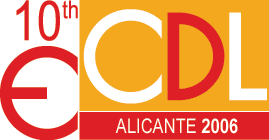
The Fedora Repository and Service Framework
Presenters' name:
Sandy Payette, Co-Director of Fedora Project and Researcher, Cornell Information Science. Carl Lagoze, Senior Research Associate, Cornell Information Science.
Abstract
Fedora provides a powerful, flexible, and secure foundation for a wide variety information management applications, including institutional repositories, digital libraries, e-research, e-scholarship, records management, digital archives, and educational software. This tutorial is an introduction to the Fedora Service Framework, which is an open-source, service-oriented architecture for digital repositories. Central to the framework is the Core Repository Service which provides essential capabilities for ingesting, storing, managing, preserving, and disseminating digital content in the form of digital objects.
Loosely coupled within the Fedora framework are supporting services that make the repository environment more than just a storage system. We will examine the repository in relationship to ingest, workflow, preservation, search, and other important services.
We will discuss the reasons one would choose Fedora as the basis for digital libraries, institutional repositories, digital preservation, scholarly communication, and related problems.
Finally, we will review Fedora's involvement in demonstrating new standard-based approaches to cross-repository interoperability via OpenURL and RDF.
Contents
- Introduction to the Fedora Service Framework
Service-oriented architecture. Reverberation effect - underlying technology enables users. Fedora-based implementations and Fedora community.
- Fedora Digital Objects
Generic Digital Object Model. Associating Services with Digital Objects. Expressing a "Network" of Digital Objects using RDF.
- Fedora Core Repository Service
Mapping Fedora to OAIS. Web service interfaces for repository management and access.
Persistent Storage: Default file system and database. Storage Resource Broker (SRB) plug-in.
Preservation Feature Set: XML for digital object storage. XML-based ingest/export. Content Versioning and Object Audit Trails. Recovery via Repository Rebuilder. Preservation support services.
RDF Capabilities: Defining object relationship and properties for digital objects. Contextualization of digital objects with extensible properties. RDF - Indexing and Querying the graph via triplestore technology.
Security and Access Control: Authentication and SSL. XACML-based Policy Enforcement. - Repository-Enhancing Services in the Framework
Advanced Ingest (Fedora 2.1). OAI Provider (Fedora 2.1). Search (Fedora 2.2). Workflow (Fedora 2.2). Preservation . Event Notification. OpenURL and Pathways Core Ontology.
- Selected Applications of Fedora
Fedora for Institutional Repositories (ARROW, NCCS/FIRE). Fedora and RDF for Advanced, Contextualized Digital Libraries (NSDL, Encyclopedia of Chicago). Fedora and e-Research, e-Scholarship and Scholarly Publication (eSciDoc, OhioLINK, DART).
Copyright ECDL - Design by JASBAT
